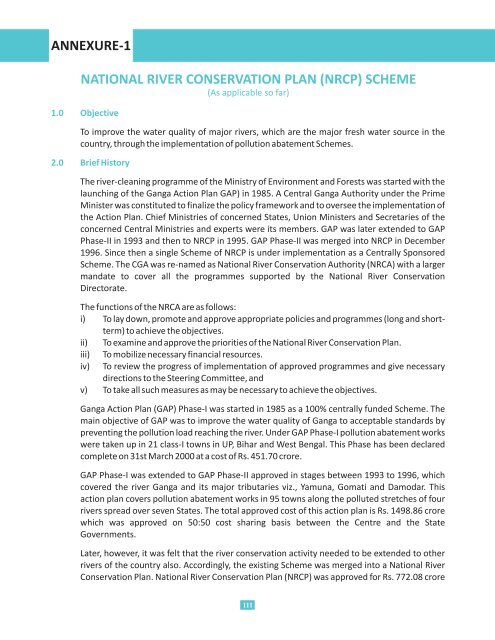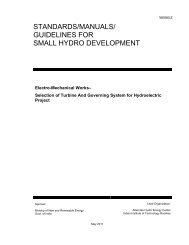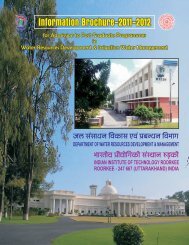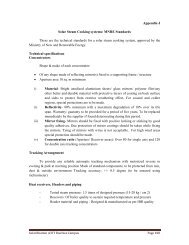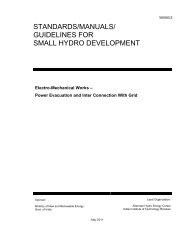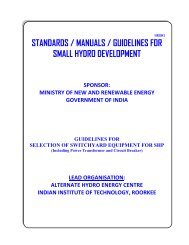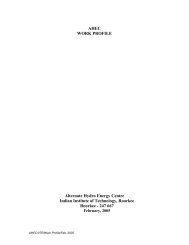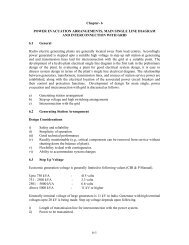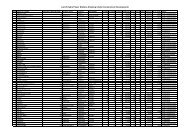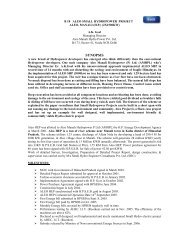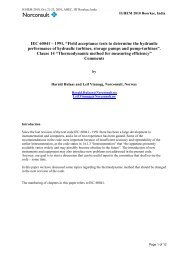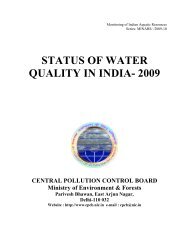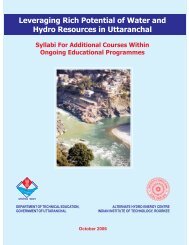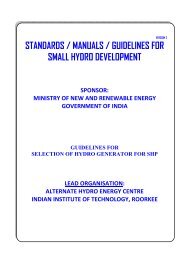annexures - Indian Institute of Technology Roorkee
annexures - Indian Institute of Technology Roorkee
annexures - Indian Institute of Technology Roorkee
Create successful ePaper yourself
Turn your PDF publications into a flip-book with our unique Google optimized e-Paper software.
ANNEXURE-1NATIONAL RIVER CONSERVATION PLAN (NRCP) SCHEME(As applicable so far)1.0 ObjectiveTo improve the water quality <strong>of</strong> major rivers, which are the major fresh water source in thecountry, through the implementation <strong>of</strong> pollution abatement Schemes.2.0 Brief HistoryThe river-cleaning programme <strong>of</strong> the Ministry <strong>of</strong> Environment and Forests was started with thelaunching <strong>of</strong> the Ganga Action Plan GAP) in 1985. A Central Ganga Authority under the PrimeMinister was constituted to finalize the policy framework and to oversee the implementation <strong>of</strong>the Action Plan. Chief Ministries <strong>of</strong> concerned States, Union Ministers and Secretaries <strong>of</strong> theconcerned Central Ministries and experts were its members. GAP was later extended to GAPPhase-II in 1993 and then to NRCP in 1995. GAP Phase-II was merged into NRCP in December1996. Since then a single Scheme <strong>of</strong> NRCP is under implementation as a Centrally SponsoredScheme. The CGA was re-named as National River Conservation Authority (NRCA) with a largermandate to cover all the programmes supported by the National River ConservationDirectorate.The functions <strong>of</strong> the NRCA are as follows:i) To lay down, promote and approve appropriate policies and programmes (long and shortterm)to achieve the objectives.ii) To examine and approve the priorities <strong>of</strong> the National River Conservation Plan.iii) To mobilize necessary financial resources.iv) To review the progress <strong>of</strong> implementation <strong>of</strong> approved programmes and give necessarydirections to the Steering Committee, andv) To take all such measures as may be necessary to achieve the objectives.Ganga Action Plan (GAP) Phase-I was started in 1985 as a 100% centrally funded Scheme. Themain objective <strong>of</strong> GAP was to improve the water quality <strong>of</strong> Ganga to acceptable standards bypreventing the pollution load reaching the river. Under GAP Phase-I pollution abatement workswere taken up in 21 class-I towns in UP, Bihar and West Bengal. This Phase has been declaredcomplete on 31st March 2000 at a cost <strong>of</strong> Rs. 451.70 crore.GAP Phase-I was extended to GAP Phase-II approved in stages between 1993 to 1996, whichcovered the river Ganga and its major tributaries viz., Yamuna, Gomati and Damodar. Thisaction plan covers pollution abatement works in 95 towns along the polluted stretches <strong>of</strong> fourrivers spread over seven States. The total approved cost <strong>of</strong> this action plan is Rs. 1498.86 crorewhich was approved on 50:50 cost sharing basis between the Centre and the StateGovernments.Later, however, it was felt that the river conservation activity needed to be extended to otherrivers <strong>of</strong> the country also. Accordingly, the existing Scheme was merged into a National RiverConservation Plan. National River Conservation Plan (NRCP) was approved for Rs. 772.08 crore111


